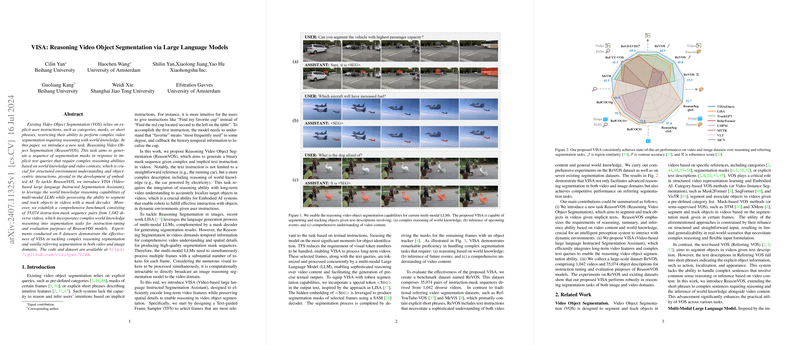An Analysis of "VISA: Reasoning Video Object Segmentation via LLMs"
The paper "VISA: Reasoning Video Object Segmentation via LLMs" introduces an innovative approach to video object segmentation, termed Reasoning Video Object Segmentation (ReasonVOS). This task addresses the shortcoming of existing Video Object Segmentation (VOS) systems, which typically depend on explicit user instructions limited to pre-defined categories, masks, or explicit short phrases. VISA's approach aims to understand implicit text instructions that require complex reasoning abilities based on world knowledge and video context, thus attempting to bridge a significant gap in current methodologies by supporting structured environment understanding and object-centric interactions, crucial for advancing Embodied AI.
Methodology and Architecture
The proposed VISA consists of three primary components: a Text-guided Frame Sampler, a multi-modal LLM, and an Object Tracker. VISA utilizes the reasoning capabilities of multi-modal LLMs combined with a mask decoder that empowers the model to segment and track objects in videos effectively. The system selects relevant frames in a video based on implicit text instructions using the Text-guided Frame Sampler, leveraging LLaMA-VID to abstract each frame into tokens for efficient processing. Subsequently, these tokens, along with the text queries, are processed by a multi-modal LLM to derive a segmentation mask for the principal frame. The output mask for the remaining frames is obtained through an object tracker using an XMem model.
VISA employs instruction tuning via a novel dataset—ReVOS—comprising over 35,000 instruction-mask pairs from 1,042 videos, integrally considering complex world knowledge reasoning. The benchmark established through ReVOS ensures a comprehensive evaluation of VISA's effectiveness in handling complex reasoning segmentation tasks.
Experiments and Results
The authors conducted extensive experiments on eight datasets to evaluate VISA's performance, focusing on both reasoning and traditional referring segmentation tasks across video and image domains. The results demonstrate VISA's effectiveness over conventional methods, especially in tasks requiring reasoning with non-explicit text instructions. Notably, VISA achieves substantial improvements in the robustness scores indicating reduced hallucination issues—a critical challenge in segmentation tasks demanding common sense reasoning with video content.
Implications and Future Prospects
This research has broad implications for the development of more nuanced AI systems capable of interacting with dynamic environments and engaging in complex reasoning beyond conventional tasks. By integrating advanced reasoning capabilities into video object segmentation, VISA sets a precedent for developing coherent visual understanding in Embodied AI applications. Moreover, the introduction of ReasonVOS as a task paves the way for future studies focusing on utilizing multi-modal LLMs to achieve more sophisticated interaction insights in AI.
In future work, addressing limitations such as capturing small objects and gathering long-term temporal information more effectively is crucial. The potential for improvements could also lie in leveraging more powerful multi-modal LLMs and expanding the model's temporal understanding scope. As these aspects are incrementally refined, the applications of such models in real-world scenarios will likely become more prevalent, contributing to significant strides in AI capabilities.
Conclusion
The paper "VISA: Reasoning Video Object Segmentation via LLMs" stands as an impressive contribution to the field of AI, particularly in enhancing VOS systems' ability to perform complex reasoning. Through its innovative methodology and comprehensive dataset evaluation, VISA not only improves the current state of VOS but also sets a foundation for future research that further integrates language understanding and video context into AI systems. Such developments are pivotal to realizing the potential of AI in various practical applications, shaping the next generation of intelligent, perceptive, and interactive systems.
